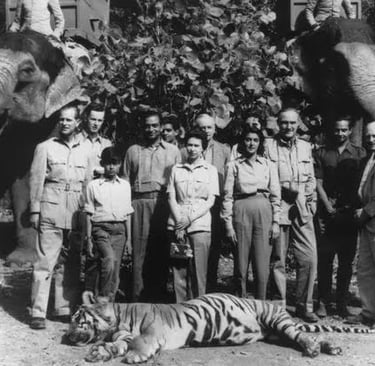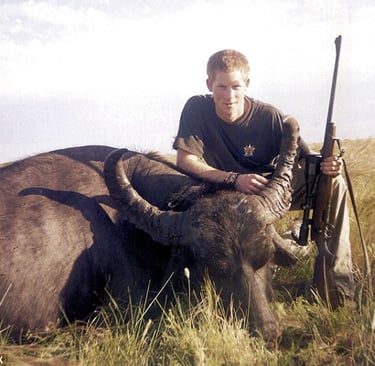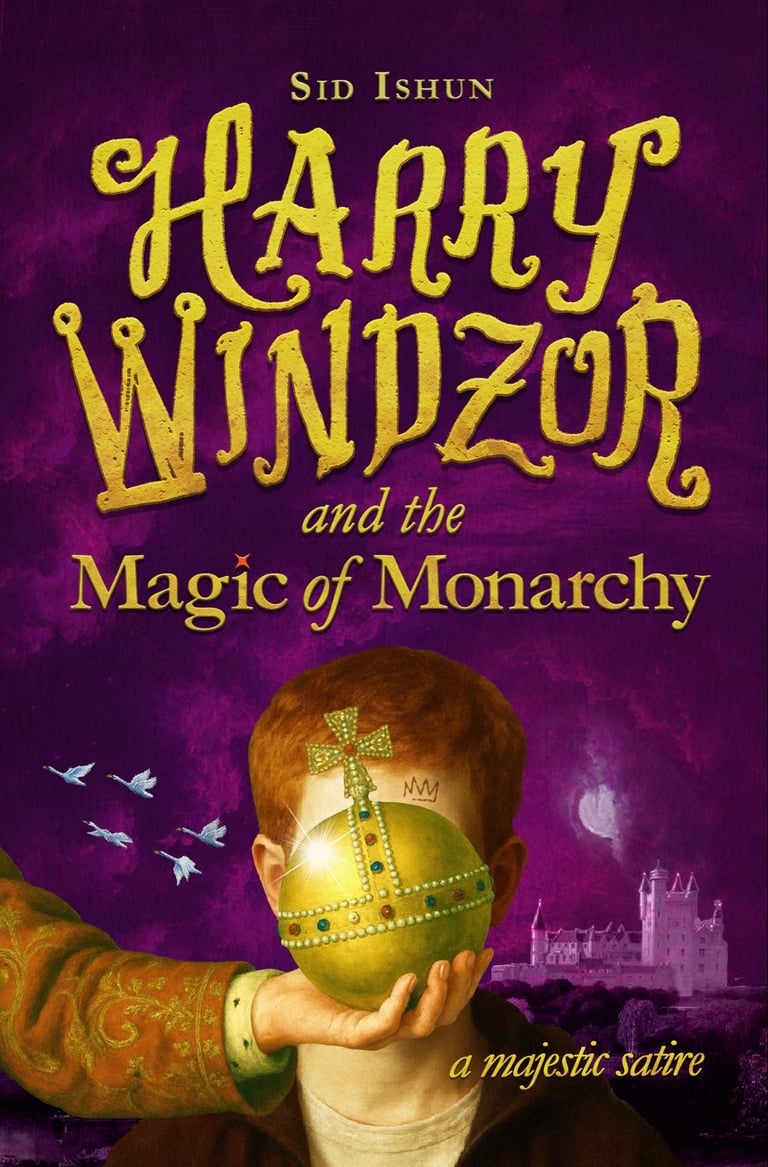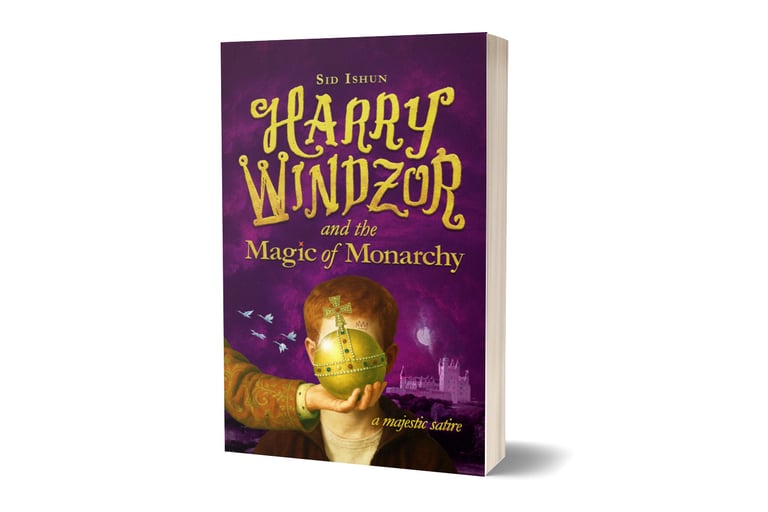Royally Bloodthirsty
Royal expert and author of Harry Windzor and the Magic of Monarchy, Sid Ishun scrutinises the devastating ecological impact of the British royal family.
10/8/20256 min read
Charles Windsor is often referred to as an environmentalist, however his and his family’s actions, appetites, traditions and hobbies show quite the opposite to be true. To be an environmentalist, one needs to be open-minded, and most importantly, to offer nature respect. Is a tiger a trophy or a fearsome yet beautiful animal? Can it be both - well it seems to the late Prince Philip it can be. In 1961, the very same year that he became the inaugural president of the World Wildlife Fund, he enjoyed a hunting trip to India during which, amongst much slaughter, he shot a tiger. Although, to call these acts “hunting” is an extreme glorification and romantification of the event. Philip did not bravely track through the jungle in search of a fair fight and resolved to look the beast in the eye, like Robert Muldoon and the raptors in Jurassic Park. No, it did not matter how clever the tiger was, it stood no chance of getting away or being able to fight back. As always, others did the dirty work for the royals, trapping the terrified tiger within a circle of elephants. Then, as the tiger was cruelly given one narrow passage out to salvation, the prince executed it from the safety of a raised tower.


Philip and the Queen proudly posed for a photograph next to it, before sending the pelt to be their trophy at Windsor Castle - could they not have just found a fridge magnet instead? Like many other unfortunate things, this hobby very much runs in the family and it seems the Windsors/Sax-Coburg-Gothas have always found it much easier to rack up kill counts of endangered species than they do carrying out mundane engagements. On a hunting trip In 1921, the future Edward VIII bagged 17 tigers, 10 rhinos, 2 leopards and 2 bears. Ten years earlier, QEII’s grandfather George V shot 21 tigers, 8 rhinos and a bear on one of his jaunts. How many of us have seen a taxidermied specimen in a natural history museum? Next time you do, have a look at the plaque - it will most likely proudly display a king’s name. Considering that in 2010 the global population of wild tigers reached a precipitous low of around 3,200, the royal family has not played an inconsequential role in their fate. Certainly, it can be stated, their negative impacts far outweigh the charity and ambassadorial work in conservation that they love to profess.


These royal pastimes are keenly passed down and carry on today in the “modern royal family”. Philip and Charles are reported to have shot 50 wild boars in a single day when on a father and son hunting trip to Germany. And so it continues with the next generation with William and Harry. But where does this bloodlust start? Well, for a young prince, who like most children probably views wildlife with wonder and awe, they are treated to The Blooding. Both William and Harry were each forced to make their first kill at around fifteen years of age - but to ensure that this act left its mark on them, both emotionally and physically, the still warm blood of the cornered animal was smeared on their faces. Unsurprisingly, this event lingers on in Harry’s thoughts, with him describing in his memoir, Spare, how he had his head forced inside the carcass of the stag. Alas, it seems that this family ritual did not put him off this colonialist hobby. Although only being published many years later, there is the infamous photo of a twenty-year-old, smirking Harry crouched beside a water buffalo that he killed during a polo trip to Argentina in 2004.
With hunting or culling, arguments can be made for their necessity as a tool in conservation. Deer numbers in parts of the UK do need to be kept under control to stem the damage that over population of grazers can have on ecosystems. This is due to their natural predators like wolves being exterminated by humans and therefore requiring our continued intervention of the increasingly threadbare circle of life. Ironically, we can again thank the British royal family for this. As the fictionalised version of the Queen Mother jovially explains to Harry in my satirical book Harry Windzor and the Magic of Monarchy as they explore Balmoral Estate’s woodland:
“We can take the credit for getting rid of the wolves. Back in the thirteenth-century, Edward I ordered their extermination – even appointed a knight to carry out the task. We completely got rid of them in England by Henry VII’s reign. Took us till the eighteenth-century to kill off the last ones in Scotland though ... but nothing much survives for long when we are in charge.”
But the argument for shooting being the need to maintain balance is completely exposed when considering the aristocratic pastime of gamebird shooting. 50 million non-native, ravenous pheasants are reared and released in the UK each year. This biomass outweighs the entire wild bird population and has a long-term disastrous effect on our countryside and wildlife. When landowners push back against rewildling and species reintroduction, like pine martens or lynx, they blithely overlook that they are responsible for by far the largest ongoing augmentation of British wildlife. On top of these birds outcompeting the wild avian populations, devouring reptiles, and turning country roads into a cross between a game of chicken and It’s A Knockout, their presence enables and encourages the worst practices of land stewardship. A Freedom of Information act forced the Windsor estate to admit that during 2013 (most likely a usual and representative year of their land management practices), over 7,000 wild animals were killed. While some of these figures (325 squirrels and 56 roe deer) were accredited to the wishes of foresters for arguably pragmatic reasons, this cannot be said for the 9 moles killed to protect the aesthetics of the formal gardens and the 159 foxes killed for the sake of leaving more pheasants to be left for the benefit of the sort of "straightforward shooting weekend” that Prince Andrew infamously hosted for Ghillaine Maxwell.
And so, even though the royals have been shamed into (mostly) moving on from hunting mega fauna from other countries, their need to feel powerful by killing lesser creatures carries on and continues to play an integral part of the biodiversity crisis in the UK. It was Queen Victoria and Prince Albert who popularised grouse and pheasant shoots, starting with their purchase of Balmoral Estate in 1852, with endless waves of old - and now, new money - aristocrats buying country estates as their playthings and changing the face of our uplands and Highlands. It was suggested in 2019 that half of Scotland’s rural land was owned by just 432 landowners. Another study in 2019 concluded that over three-quarters of a million acres (over twice the land area of Greater London) of England and Scotland’s national parks are used as driven grouse moors. The damage to habitats due to routine burning of heathland, the knockon effects of increased risk of flooding of downstream towns, and the illegal persecution of birds of prey are indefensible. I am deeply unsurprised that Harry omitted writing about the time he was alleged to have shot two hen harriers at Sandringham Estate in 2007 in Spare. It’s fortunate for him that: “More than 30 different laws stipulate that police are barred from entering the private Balmoral and Sandringham estates without the Queen’s permission to investigate suspected crimes, including wildlife offences and environmental pollution.”
And what is this all for? Just so a tiny group of people can have a rollicking good time shooting feathery balloons. The Duchies, the Crown Estate and all of the estates that look up to them could play an invaluable role in nature recovery in this country. But, as history has taught us, this change will not and cannot happen while we have an antiquated and ecologically-illiterate royal family sitting at the top of their warped tree of life. Like the tendrils of rhododendrons suffocating our woodland, and the barren, featureless deserts of grouse moors, overseen by the modern day equivalents of General Melchett gurning over his blank map, if we want to give UK wildlife a chance of recovery, we need to remove the Windsor tree, root and branch.


Sid Ishun is a royal expert and author of Harry Windzor and the Magic of Monarchy. Available from now on Kindle, Audible and paperback on Amazon: https://www.amazon.co.uk/dp/B0FMP64NKS and as an audiobook from Audible and Apple Books.
Website: www.harrywindzor.com
Sources
Queen of the World - Robert Hardman
Spare - Prince Harry
Who Owns England - Guy Shrubsole
The Lie of the Land - Guy Shrubsole
http://ar2013.thecrownestate.co.uk/pdfs/TCE%20Annual%20Report%202013.pdf
https://www.newsweek.com/fact-check-prince-harry-photo-water-buffalo-hunt-1772544
https://www.bbc.co.uk/news/uk-scotland-47963208
https://protectthewild.org.uk/news/royal-immunity-from-crime/




